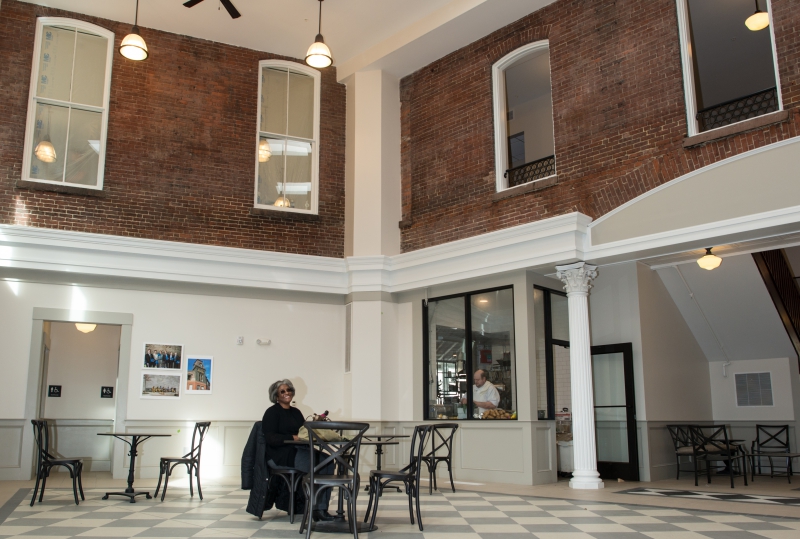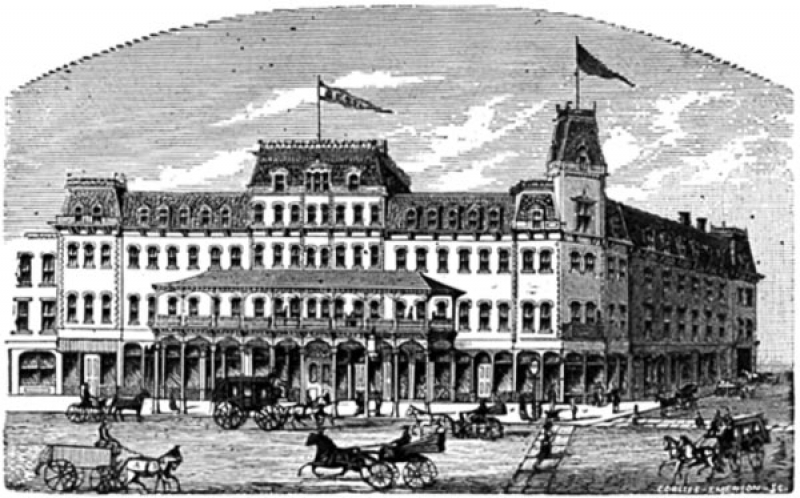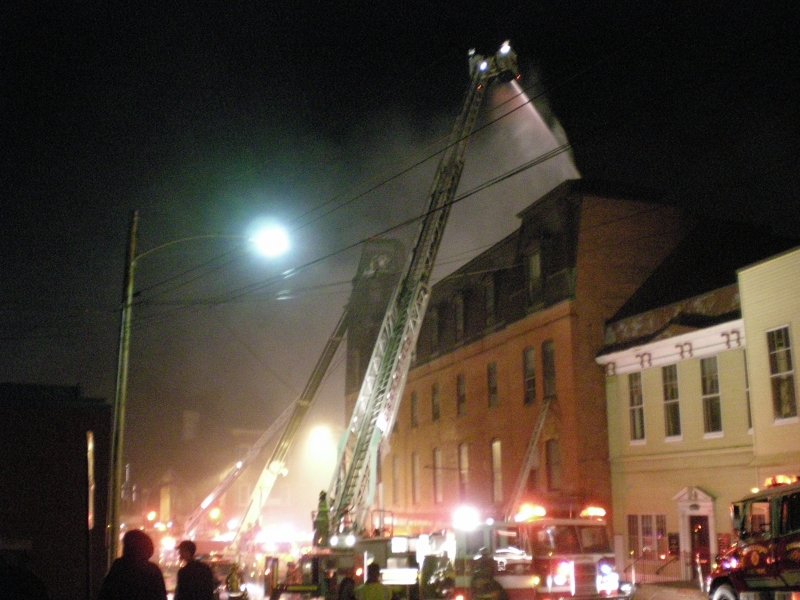Restoration of the Brooks House, an iconic building built in 1871 that spans half a block on Main Street, has brought grandeur back to downtown Brattleboro. The Second Empire-style building has a storied history as a premier hotel and summer resort complete with ballroom and famous visitors, including writer Rudyard Kipling. The building has been reclaimed from the destructive forces of fire and water thanks to the dogged determination of a handful of visionaries – led by Bob Stevens of Stevens & Associates and his partners Craig Miskovich, Ben Taggard, Drew Richards and Peter Richards – who recognized that saving the building was pivotal to a vibrant downtown. Restaurants, retail stores, upscale apartments, office space and two Vermont colleges are pumping life back into a building that was nearly destroyed by a five-alarm fire in April, 2011.
Today, the renovated building is a stylish mix of historical detail fused with contemporary design to once again serve as the focal point for a resurgent downtown. “The underlying purpose was to help revitalize Brattleboro and create energy. To make Brattleboro better than it was before. To activate Main Street. To get more people downtown and help the town as a whole,” said Bob Stevens.
Extensive work to clean up, stabilize and rebuild the structure, led by Breadloaf Construction of Middlebury, began in April 2012. “It was a gem,” Stevens said of the Brooks House, which over the years had lost its luster. “It’s a beautiful, iconic building.” It cost a million and a half dollars just to stabilize the building, Stevens said; the final cost of the restoration was approximately $24 million. The first order of business after the cleanup was to preserve what was there, Stevens said. “We didn’t replicate all of the original architectural features that had been removed over the years. We did restore everything that was remaining at the time of the fire and replicated the historic storefronts. What we rebuilt, we rebuilt right,” outside and in.
The exterior of the roof was stabilized by slate and copper flashing and the dormers and all exterior moldings were built to match the old ones. The windows were all restored with insulated glazing.
Focusing on the interior, Stevens said, the group thought about the building’s public spaces and wanted to create a gathering place that would stand out and make access to the new 23 apartments appealing. “We wanted to respect the significance of the architectural history and reflect the character of the building,” Stevens said, but also to bring in newer energy. They reorganized the circulation of the ground floor of the original hotel lobby, added a grand staircase up to the second floor and opened up a two-story atrium toward the back of the building that soars 25 feet. Arched windows with scalloped railings draw the eye toward the second floor. Two important features were retained: the original iron columns in the lobby were restored and painted and topped with Corinthian capitols.
“We looked to create something special,” Stevens said, and they did. “We created a new, larger, well-proportioned public space. It’s the living room of the building.” The area has a rear entry as well, and provides access to the Community College of Vermont and Vermont Technical College, WOW Yogurt, Brilliance, Turquoise Grill and two other retail spaces yet to be rented. On the other side, windows provide a peek into the prep area of Duo Restaurant, which anchors the dominant space on the corner of Main and High Streets. Stevens sees this hub as a “lively, active lounge” for people to congregate.
No detail was spared in providing “a sense of arrival and significance,” in Stevens’ words. “Energy” is how interior designer Priscilla Cotton of Cotton Designs Associates describes it. Her challenge was to balance period details with modern aesthetics. “I was trying to tell the story of the building through finishes,” she said. “It could have been all sheetrock and carpets, but that would not have told the history of that building.”
The magnificent tiled floor, the wainscoting, the classic entablature are the details that reinforce the feel of elegance, defined by the soft, neutral colors on the walls. The black-and-white checkerboard tiled floor at the front of the building changes to a subtler gray-and-white checkerboard, chosen, Cotton said, as a nod to period style, yet given a modern twist by using large tiles – 18-by-18 – in an offset pattern. It’s an area-rug look, Stevens said. Likewise, the brilliant chandelier in the entryway is fashionably current with rings of steel swirling around light fixtures that resemble candlesticks.

The completed atrium creates a light, airy open space functioning as a lobby with access to all the retail, office and residential spaces.
The grand oak staircase leads to the office spaces on the second floor, and the large, light-filled offices of Oak Meadow, developers of home schooling curricula, in what was the old hotel’s ballroom. Tenants reside on the third and fourth floors, where there are 23 one-, two-, and three-bedroom apartments, and two penthouse suites take over the fifth floor. All are leased and there is a waiting list, Stevens said. In fact, most of the apartments were leased sight-unseen by the fall of 2012, he said, which was crucial to the complex financing of the development. “People wanted to live downtown … they were willing to take a chance,” Stevens said.
Most of the units are two-bedroom dwellings of about 1,000 square feet with two bathrooms and open-concept kitchen and living areas, although apartment sizes vary from 600 square feet to 1,700 square feet. Tenants had a choice of three different looks and upgrades, said Cotton: the Stickney Brook, which features white kitchen cabinets; the Whetstone Brook, with espresso-dark cabinets; and the Broad Brook, with maple cabinets. Different flooring options were offered as well. For Cotton, the apartments were a clean slate upon which to offer tenants “something grand and beautiful. It’s not extravagant, but it’s not cheap. We did not cut corners.” Pilasters and soffits strategically placed along the long, carpeted hallways add architectural interest and serve to visually break up the lengthy space. One of the units has perhaps the most distinctive feature: a spiral staircase from the living room leads up to the tower room with breathtaking panoramic views of the river, mountains and downtown Brattleboro. This is where Rudyard Kipling is said to have played poker.
Tenants, college students, shoppers, office workers and diners all promise to bring a diversity of culture and vibrancy downtown. “We wanted a mix of markets,” Stevens said. “Diversity gives it strength.” Said Cotton, “This is what needed to happen for many years – to bring something lively into town. I feel we were telling a story – through what you see – about how we feel about Brattleboro and its people.”
Stevens and his partners are continuing to expand the scope of the Brooks House development with plans to tear down Frankie’s pizza place, behind the Brooks House in the corner of the Harmony Parking Lot, and put up a park. While Stevens was the point man for much of the project, he is quick to give credit to many others for the success of the Brooks House project, including Breadloaf Construction. “They were craftsmen. They wanted to do it right and did justice to the original builders of the Brooks House. They brought the same quality of craftsmanship and care.”
“So many people pulled this together,” he continued. In addition to his team of fellow investors, who he said all have a history of civic engagement with the community and were key supporters of the project, “I had a team of people working on the design, an engineer management team, and the community. There were a hundred people behind us. They cared about this building and wanted to see it be successful. Our goal was to revitalize the building in a way that was better than before. Our goals were definitely met. We’re pretty happy with the results.”
























































